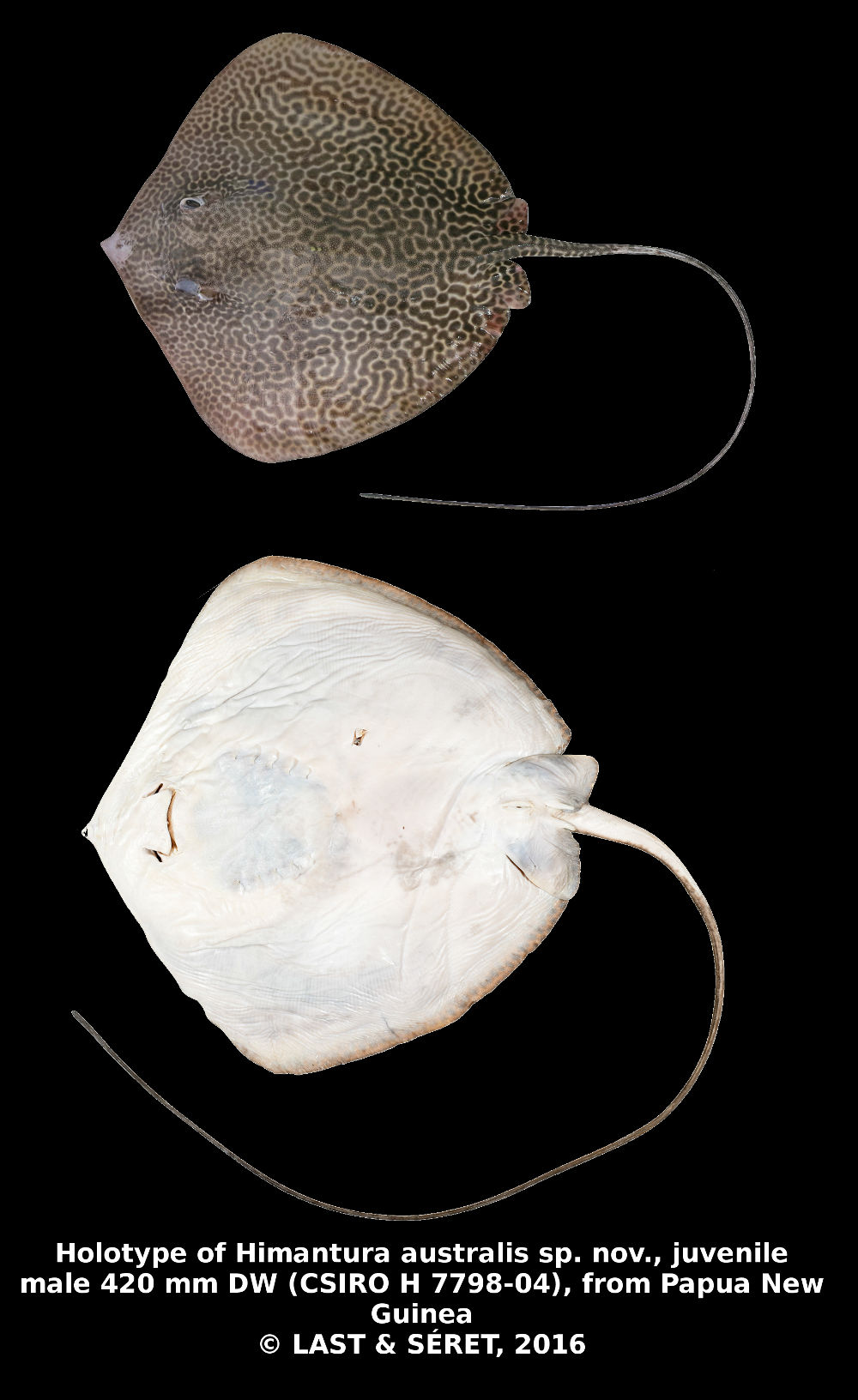Himantura australis
Last, White & Naylor, 2016
Himantura australis
Classification: Elasmobranchii Myliobatiformes Dasyatidae
Reference of the original description
Three new stingrays (Myliobatiformes: Dasyatidae) from the Indo–West Pacific. Zootaxa, 4147(4), 377–402
Three new stingrays (Myliobatiformes: Dasyatidae) from the Indo–West Pacific. Zootaxa, 4147(4), 377–402
Types
Himantura australis
Holotype: CSIRO: H 7798-04; Paratype: CSIRO: H 1134-1; CSIRO: H 1463-3; CSIRO: H 1920-01; CSIRO: H 4016-01; CSIRO: H 4422-01; CSIRO: H 4542-06; CSIRO: H 7839-01; CSIRO: H 7840-01; KFRS: unregistered (field accession 220349); KFRS: unregistered (field accession 220420); KFRS: unregistered (field accession 230247); NTM: S 11144-001; NTM: S 11507-006;
Himantura australis
Holotype: CSIRO: H 7798-04; Paratype: CSIRO: H 1134-1; CSIRO: H 1463-3; CSIRO: H 1920-01; CSIRO: H 4016-01; CSIRO: H 4422-01; CSIRO: H 4542-06; CSIRO: H 7839-01; CSIRO: H 7840-01; KFRS: unregistered (field accession 220349); KFRS: unregistered (field accession 220420); KFRS: unregistered (field accession 230247); NTM: S 11144-001; NTM: S 11507-006;
Description :
Citation: Himantura australis Last, White & Naylor, 2016: In: Database of modern sharks, rays and chimaeras, www.shark-references.com, World Wide Web electronic publication, Version 12/2025
Please send your images of "Himantura australis" to info@shark-references.com

Holotype of Himantura australis sp. nov, juvenile male 420 mm DW (CSIRO H 7798-04), from Papua New Guinea © Last & Séret, 2016

Holotype of Himantura australis sp. nov, juvenile male 420 mm DW (CSIRO H 7798-04), from Papua New Guinea © Last & Séret, 2016
Common names
 Australian Whipray
Australian Whipray
 Australian Whipray
Australian Whipray
Short Description
Original diagnosis after LAST, WHITE & NAYLOR, 2016 [24346]: A species of Himantura distinguished by a combination of the following features: disc weakly rhomboidal; preorbital snout moderately short (length 19–22% DW), rather broad, angle 117–127°, with a distinct apical lobe; lateral apices narrowly rounded; orbits moderately large, often strongly protruding (particularly in young); 1–2, mostly heart-shaped suprascapular denticles (not preceded before and after by a row of smaller primary denticles); secondary denticle band developed before birth; dorsal surface of juveniles (smaller than 370 mm DW) dark spotted or with spots and weak reticulations, subadults and adults (exceeding 390 mm DW) more strongly reticulated; dorsal tail of juveniles with 3 rows of spots before caudal sting, faint dark saddles beyond sting (tail lacking alternating black and white bands); tail uniformly dark ventrally; pectoral-fin radials 146–152; vertebral centra (excluding synarcual) 123; including synarcual 124.
Original diagnosis after LAST, WHITE & NAYLOR, 2016 [24346]: A species of Himantura distinguished by a combination of the following features: disc weakly rhomboidal; preorbital snout moderately short (length 19–22% DW), rather broad, angle 117–127°, with a distinct apical lobe; lateral apices narrowly rounded; orbits moderately large, often strongly protruding (particularly in young); 1–2, mostly heart-shaped suprascapular denticles (not preceded before and after by a row of smaller primary denticles); secondary denticle band developed before birth; dorsal surface of juveniles (smaller than 370 mm DW) dark spotted or with spots and weak reticulations, subadults and adults (exceeding 390 mm DW) more strongly reticulated; dorsal tail of juveniles with 3 rows of spots before caudal sting, faint dark saddles beyond sting (tail lacking alternating black and white bands); tail uniformly dark ventrally; pectoral-fin radials 146–152; vertebral centra (excluding synarcual) 123; including synarcual 124.
Distribution
off Papua New Guinea and northern Australia, from Shark Bay (off Western Australia) to Brisbane (off Queensland) [24346] Source: www.gbif.org
off Papua New Guinea and northern Australia, from Shark Bay (off Western Australia) to Brisbane (off Queensland) [24346] Source: www.gbif.org
Dentition
Teeth in a juvenile paratype (CSIRO H 4542-06) small, subequal in size in upper and lower jaws; narrowly rhombic with 1–2 low, transverse ridges on crown, ridges separated by prominent groove; ~59 vertical rows in upper jaw [24346]
Teeth in a juvenile paratype (CSIRO H 4542-06) small, subequal in size in upper and lower jaws; narrowly rhombic with 1–2 low, transverse ridges on crown, ridges separated by prominent groove; ~59 vertical rows in upper jaw [24346]
Remarks
shark-references Species-ID=14669;
shark-references Species-ID=14669;
Parasites (arranged by Jürgen Pollerspöck)
Cestoda
Cestoda
- Acanthobothrium cannoni Campbell & Beveridge, 2002 [26821]
- Rhinebothrium nickoli Coleman, Beveridge & Campbell, 2018 [26943]
- Rhinebothrium vandiemeni Coleman, Beveridge & Campbell, 2018 [26943]
- Ruptobothrium louiseuzeti Coleman & Beveridge & Campbell, 2019 [27352]
- Scalithrium australiense Coleman & Beveridge & Campbell, 2019 [27352]
- Stillabothrium jeanfortiae Forti, Aprill & Reyda, 2016 [24898]

















